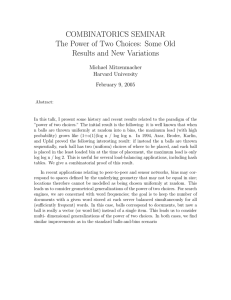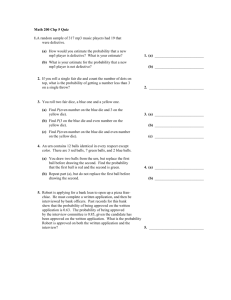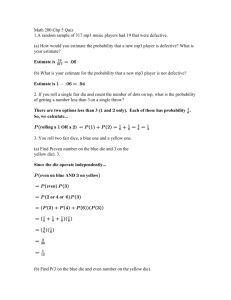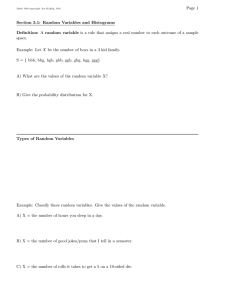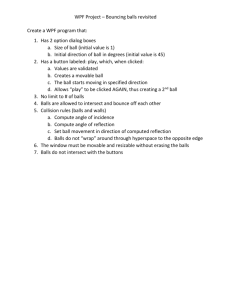18.440 Probability and Random Variables March 14, 2007 Department of Mathematics
advertisement
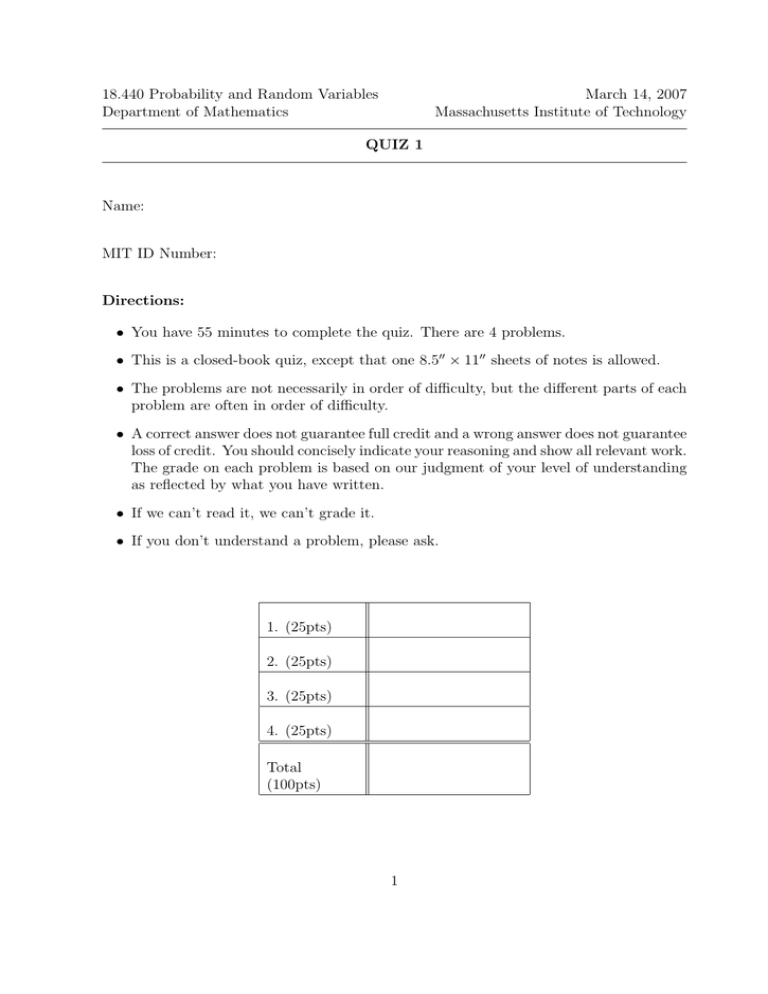
18.440 Probability and Random Variables Department of Mathematics March 14, 2007 Massachusetts Institute of Technology QUIZ 1 Name: MIT ID Number: Directions: • You have 55 minutes to complete the quiz. There are 4 problems. • This is a closed-book quiz, except that one 8.500 × 1100 sheets of notes is allowed. • The problems are not necessarily in order of difficulty, but the different parts of each problem are often in order of difficulty. • A correct answer does not guarantee full credit and a wrong answer does not guarantee loss of credit. You should concisely indicate your reasoning and show all relevant work. The grade on each problem is based on our judgment of your level of understanding as reflected by what you have written. • If we can’t read it, we can’t grade it. • If you don’t understand a problem, please ask. 1. (25pts) 2. (25pts) 3. (25pts) 4. (25pts) Total (100pts) 1 Problem 1: (25 points) There are 10 balls, labeled 1 through 10, in a bin. Balls labeled #1-4 are red, #5-9 are blue, and ball #10 is green. All 10 balls are taken out of the bin one at a time independently without replacement. (a) Find the probability that balls labeled 1 and 2 are removed consecutively. (b) Find the probability that the second, third, and fourth balls taken out consist of 1 red and 2 blue balls. 2 Problem 2: (25 points) There are 10 balls labeled 1 through 10, in a bin. Balls labeled #1-4 are red, #5-9 are blue, and ball #10 is green. The balls are taken out one at a time independently, with color and number recorded, and then placed back in the bin for the next drawing. (a) Find the probability that the first red ball is taken out before the first blue ball. (b) Given that the first 3 balls are not blue, find the expected number of total trials until a blue ball is taken out. (c) How many different ways are there to place the 10 balls into 8 boxes (distinguishable). 3 Problem 3: (25 points) Let random variable N represent the number of days it takes for a student to finish a problem set. If the student finishes the problem set on the day it is assigned, then N = 0. Suppose that N is uniformly distributed between 0, 1, 2, 3 and Poisson distributed for N > 3. In other words, PN (n) = P (N = n) = 1 8 1 2 · λ(n−4) e−λ (n−4)! for n = 0, 1, 2, 3 for n ≥ 4 (a) Find the expected value of N . (Hint: use conditional expectation) (b) Given that it took the student at least 5 days to finish the problem set, find the probability that it took 6 or more days. 4 Problem 4: (25 points) Bin A: contains 4 red, 5 blue, and 1 green ball Bin B: contains 2 red, 2 blue, and 6 green balls For both experiments below, at each drawing, the number of the drawing and color of the ball are recorded. Then the ball is placed back into the bin where it was drawn from. • Experiment 1: Choose Bin A with probability p and Bin B with probability 1 − p. Then 20 balls are independently drawn from the chosen bin. • Experiment 2: Before each drawing, Bin A is chosen with probability p and Bin B with probability 1 − p. There are 20 drawings. (a) Find the probability that the even numbered drawings are all red or green ball for Experiment 1. (b) Let K be the total number of red balls in Experiment 2. Find the probability mass function (PMF) of the random variable K and its expected value, E(K). (c) For Experiment 1, given that the first 3 drawings are red, blue, and green, respectively, what is the probability that the balls came from Bin A? (d) For Experiment 2, conditional on the event that there were exactly 7 red balls and 11 blue balls drawn, find the probability that the first 2 drawings are red. 5 Extra page for work if needed. You may write on the back of any of the exam pages (please indicate). 6

